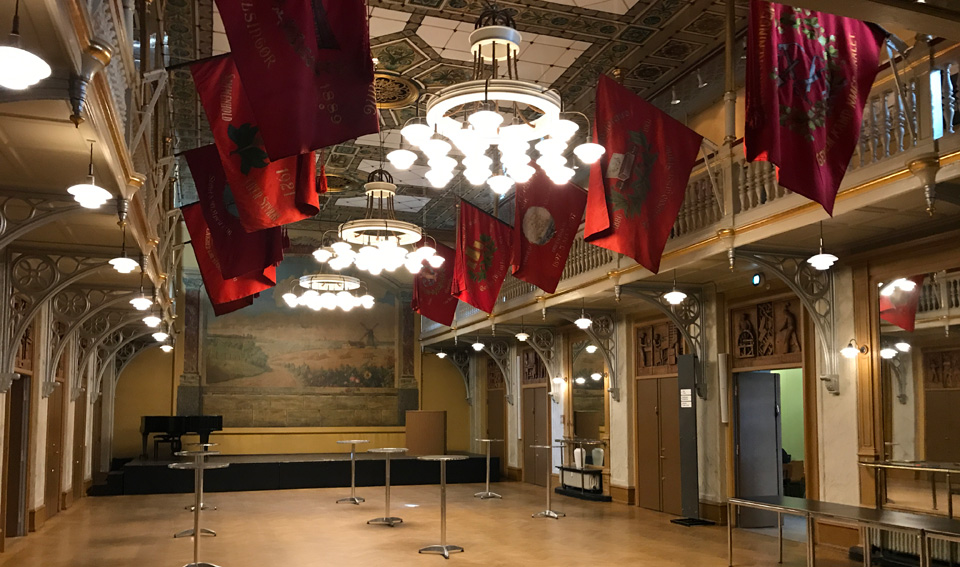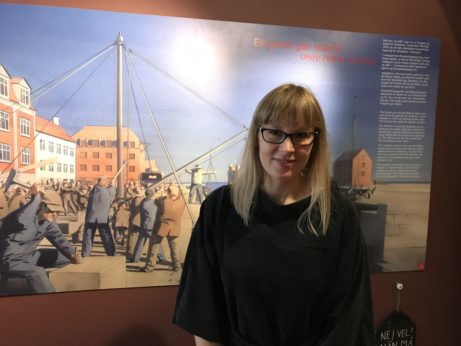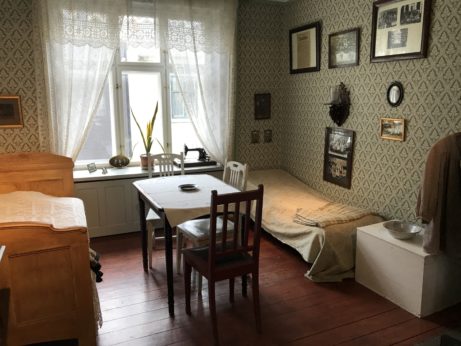
COPENHAGEN, Denmark—Popular music fans with long memories will certainly recall the tuneful number “Wonderful Copenhagen” by Frank Loesser, sung by Danny Kaye in the 1952 Hollywood musical film Hans Christian Andersen, directed by Charles Vidor, a salute to the famous 19th-century children’s storywriter whose oeuvre may still be Denmark’s historically most recognized export product.
One of the quiet wonders of that vibrant Scandinavian capital city is the Workers Museum, located in the easily accessible city center, a vast collection of rooms, meeting halls, exhibition spaces, a hands-on children’s museum section, bookstore, library, archive, study hall, video ports, conference room and offices, plus souvenir boutique, coffee shop and restaurant, all deployed on five floors.
The Workers Assembly Building dates from 1879. It was the first such edifice erected by the labor movement in Northern Europe. The grand meeting hall, with its idyllic pastoral mural behind the stage and fluttering red union banners, was for generations the principal site of labor activism in the country, until Denmark’s growing and influential labor movement got too big for the hall to accommodate. Nelson Mandela is only one among hundreds of prominent world citizens who have spoken at this forum. Around the room are more than a dozen expertly hand-carved wood bas-reliefs depicting the variety of crafts and skills that workers performed. In this grand salon the labor movement called its members to arms, families came to celebrate and dance, and crowds said their final goodbyes to beloved labor leaders and famous artists.
Among the museum’s most attractive features are the period rooms showing living conditions for the city’s working class families in the 1930s and the 1950s. The building is spacious enough for us to see re-creations of a whole living room, a complete kitchen, and bedrooms dotted with hand-embroidered fabrics and children’s toys. Stagings of shops selling articles of clothing and food indicate what was available for proletarian budgets. There’s also a pawn shop exhibition, showing what kinds of items families had to let go of when belts had to be tightened.
The café, adjacent to the 1950s display, sells the traditional “poor man’s chocolate biscuit cake” along with chicory coffee. The basement restaurant and beer hall serves historically inspired dishes cooked the old fashioned way; diners are served by waiters in traditional uniforms. In the gift shop I purchased a kitchen towel with Danish lettering spelling out the saying, “8 hours for work, 8 hours for rest, and 8 hours for what you will.”

Ideologically the museum celebrates the great mainstream of Danish social democracy with a special corner devoted to the extraordinary career of Thorwald Stauning (1873-1942), a proletarian who rose in the labor movement and became a member of the Danish parliament at age 33, and later prime minister of Denmark (1924-26 and 1929-42). In the courtyard there is also a monumental statue of Lenin which was donated to the museum by a left-wing union. The current museum newsmagazine honors the centennial of the Russian Revolution this year and respectfully reviews Chris Holmsted Larsen’s new biography of Danish Communist Carl Madsen, Den folkekaere Stalinist (The People’s Stalinist).
Stop Slavery!
Currently on view in the temporary exhibition area in the basement is “Stop slaveri!” focusing on the Denmark connection, with much space devoted to resistance and freedom movements. Denmark has not forgotten its own past. In fact, the year 2017 marks the centennial since the country sold its Danish West Indies (DWI) possessions to the United States, which then became known as the U.S. Virgin Islands. Slavery officially ended in 1848, but Denmark had its own shipping triangle in place for many years. Danish slavers picked up at least 111,000 Africans from their trading posts in Guinea on the Gold Coast, brought them in chains to the sugar plantations on St. Thomas (purchased in 1672), St. John (1718), and St. Croix (1733), and returned to Europe with sugar for Danish consumption at home.
From the beginning, the West Indian-Guinea trade company was a royal monopoly. The DWI remained state property until 1917. Towns such as Charlotte Amalie, Christiansted and Frederiksted retain their Danish names honoring members of the royal family. The European population on the islands was never more than 10 percent, however, and only a small number of those were Danes. By 1917 cane sugar was no longer profitable as sugar beets could be cultivated in Denmark. By referendum Danes voted to sell off the possessions, and Denmark received 25 million dollars in gold from the U.S.
In very few places would a museum-goer find an installation devoted to David Hamilton Jackson (1884-1946), a black laborer in the DWI fluent in Danish and English who became a teacher, worker activist and union leader, journalist and editor, jurist and judge. He went to Denmark in 1915 presenting his case for greater rights and permission to publish a newspaper. He received financial support from the Danish labor movement which he used to organize more workers into unions.

The exhibition continues with modern-day examples of slavery, including an estimated 500 cases in Denmark, such as workers lured to foreign countries with attractive job promises; women and children inducted into the sexual trafficking business; and workers in their own countries kept in debt peonage. Didactic panels throughout the exhibition urge viewers to think about the human cost of the luxuries we enjoy.
The museum’s head of collections, Margit Vilstrup, was kind enough to speak with me for half an hour or so. She offered more detail about the history of the museum itself, which dates from 1983, and we compared notes about the state of labor in our two countries as the “Internationale” played softly on the sound system and a troop of schoolchildren passed through to the next exhibition room. “Most people are quite satisfied” in Denmark, she told me, without that sense of raw competitiveness the U.S. is famous for. This is the result of many generations of labor and political pressure on the body politic, exactly the kind of mass organizing represented in the museum itself.
Today’s political spectrum includes a social democratic center (which would seem pretty Bernie Sanders-y to Americans) and a more radical left-wing Red-Green Alliance, which garners almost 8 percent of the vote. You also find several liberal parties as well as the Danish People’s Party which purports to appeal to the working class. This faux populist party can be compared to the Front National in France and the British UKIP as they oppose immigration, addressing frustrations within the working class regrading globalization and free labor markets. One of the challenges to the relatively powerful Danish labor movement is the regulation of labor in the European Union. In one move taken earlier this year, strong Danish labor unions succeeded in affecting the political process by having Uber banned from operating in the country.
Danes still show widespread support for the social welfare state, Vilstrup told me, and few parties openly stand for austerity cuts. Religious observance is minimal, and with very few exceptions most Danes favor the royalty. “In some way you could say the welfare state is the religion of Denmark.”
The Workers Museum, or Arbejder Museet in Danish, is located at Rømersgade 22. Their website can be found here. I spent four wonderful, wonderful hours there.

MOST POPULAR TODAY

Zionist organizations leading campaign to stop ceasefire resolutions in D.C. area


High Court essentially bans demonstrations, freedom of assembly in Deep South

Afghanistan’s socialist years: The promising future killed off by U.S. imperialism

Communist Karol Cariola elected president of Chile’s legislature






Comments